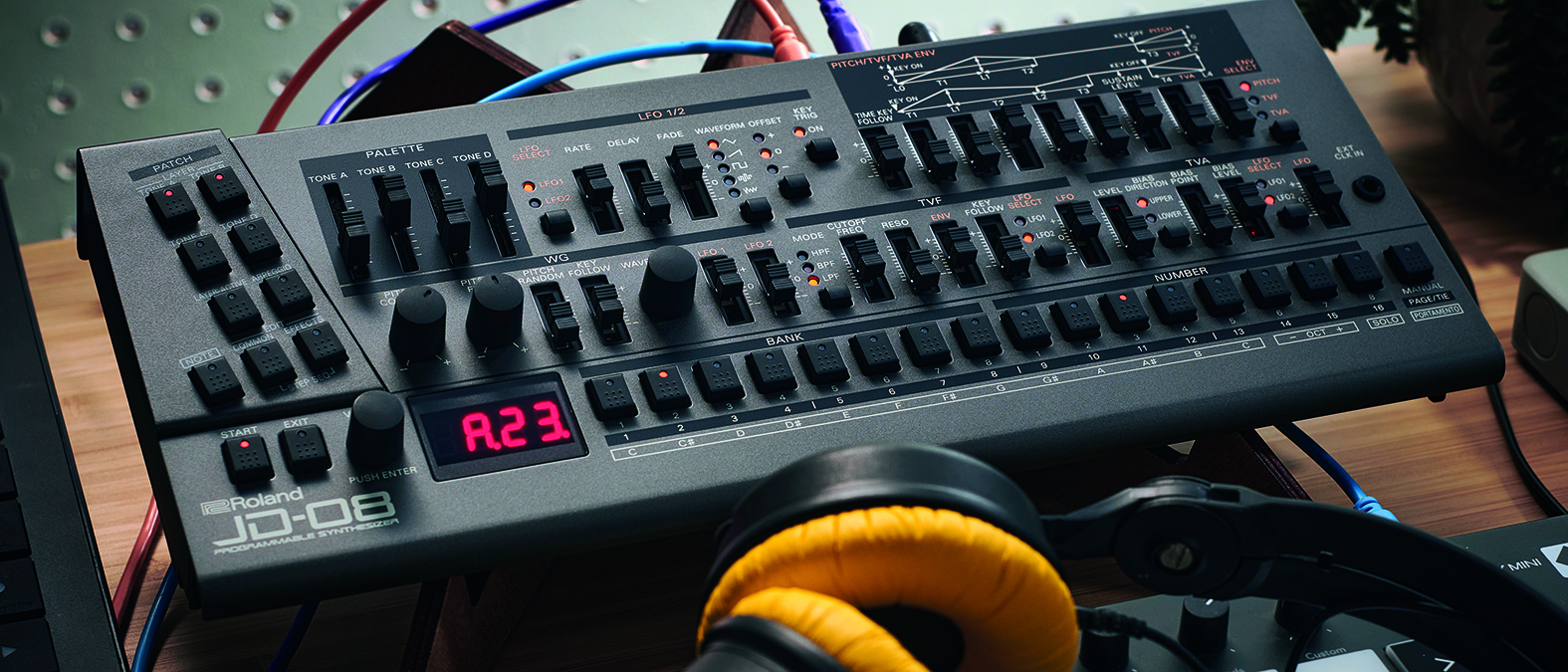MusicRadar Verdict
Adds lovely modern flourishes in an unashamedly nostalgic look and does it all within a ridiculously compact design.
Pros
- +
There’s a hell of a lot packed in here for the money.
- +
Huge sound delivers everything you’ll want and need from the original synth.
- +
We like its interfacing and mobile aspirations.
Cons
- -
Tiny footprint won’t be good for the bigger fingered.
- -
It has a very distinctive sound that won’t be for everyone.
- -
Screen doesn’t give a lot away.
MusicRadar's got your back
Roland JD-08: What is it?
Long before the analogue synth revival the Roland JD-800 brought hands-on control back to synth users. And it was much needed. This was the early ’90s and slap bang in the middle of the digital synth craze which had seen synths becoming less controllable, more menu-driven and far more, well, boring.
The JD-800 was an attempt to bring back the excitement of analogue synths, albeit surrounding a very digital engine, based on that found in Roland’s ubiquitous D-50 (more on that later).
The Japanese team responsible for the JD-800 wanted a synth without compromise and delivered just that. It went on to be used by everyone from Underworld to Genesis, Jarre to Bukem, and has become one of the most desired synths from that decade, and used well beyond it. But you do wonder if such a synth would ever get off the drawing board today.
It was massive, heavy, packed full of pricey design options, so also very expensive (probably around £5k in today’s money) and had a kind of mixed-up analogue and digital aesthetic that could confuse people. Which all goes to make the new Roland Boutique JD-08 a pretty incredible release before we’ve even powered it up.
How much stuff?
The new Boutique JD-08 has a surprising number of the original synth’s controls packed into its very small footprint. And it is really small! We're lucky enough to have an original JD-800 and just looking at the size difference is amazing! But many of the original synth’s controls are present on the JD-08, just not all 69.
To cut down on the number needed, you get sections that double up in use, so you get a single switchable set to access the two LFOs and three envelopes (of which each had separate, dedicated controls on the original). Inevitably some controls are fiddly to use due to size but they are all surprisingly manageable.
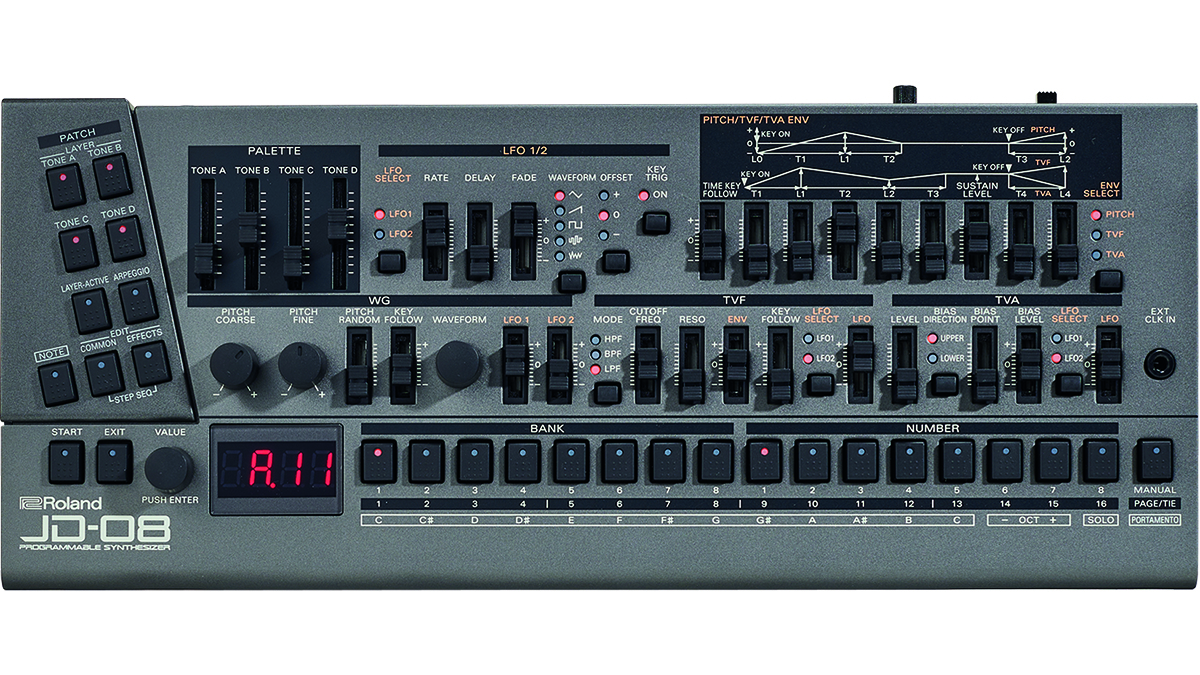
Roland JD-08: Performance and verdict
Of course, there are modern additions on the JD-08 over and above the original. There are more presets (256 locations compared to the original’s 64, which are all present), although you do get more new presets on both software JDs (Cloud and Zenology models).
Want all the hottest music and gear news, reviews, deals, features and more, direct to your inbox? Sign up here.
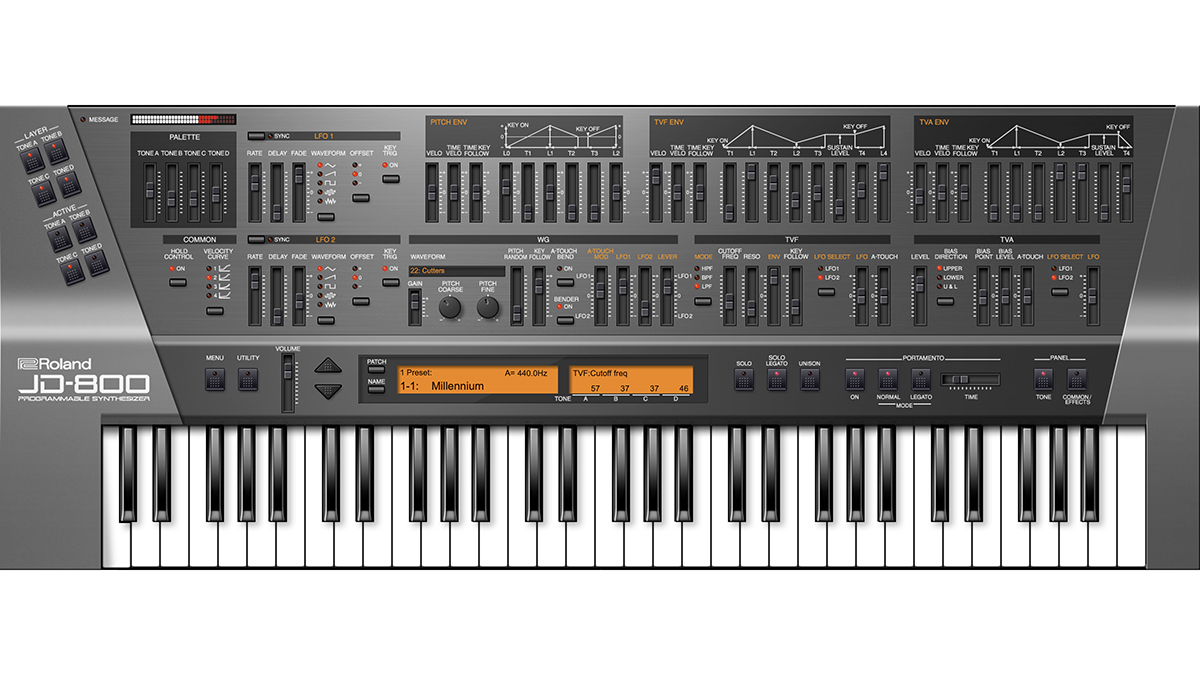
• Roland Cloud JD-800
This softsynth has the same modelled sound as the JD-08 but delivers more presets (including the original) plus expanded views.
• Roland JD-800 model expansion for Zenology
Roland gives different options to get their classic sounds. This is a JD-800 model expansion with more contemporary UI options and extra effects. It runs in the Zenology ecosphere and ZEN-Core hardware like the Jupiter X.
• Original Roland JD-800 [eBay]
With rocketing prices for the original, you’ll need at least twice the cash and ten times the room, but these have become synth design classics.
There’s more polyphony – up to 128 notes depending on how many layers you use, which is way more compared to the JD-800’s 24 – and the unit, like other Boutiques, also functions as a MIDI and audio USB interface.
You get two parts of multitimbrality (play two patches at the same time from the same or different MIDI channels) which is less than the original’s five, but another big extra is a sequencer, or dual sequencer, which can act on both parts. There’s also an arpeggiator thrown in because, well that’s what the Boutique series likes to do.
Now if all of this sounds like a lot, it is. Simple as that! And our biggest worry was how easy to implement all of this would be – new features and old control – especially given the sparseness of the screen compared to the original and the size of the sliders.
The latter issue turns out to be not so much of one – all the faders and dials are surprisingly responsive – and stepping between layers and the various parts of the machine is ok, if not mindblowing.
The sequencing side of the machine is very easy to do as well and the dual nature of it allows very complex patterns to be set up quickly. But the JD-08 is not massively easy to program when it comes to creating or editing those sounds, as you simply don’t get the screen feedback – at least not compared to the original where everything is laid out for you.
Now if all of this sounds like a lot… it is. Simple as that!
That all said, Roland has done a spectacular job of at least giving you access to the JD-800 power through an interface the size of an iPad – you just might need to work a little harder to make the most of it.
Yet as we write this there is good news on this score. There is at least one new third-party software editor available for the JD-08. Called The Roland JD-08 Synthesizer MIDI editor, it has been created by Momo and puts every parameter on your computer screen for you to tweak. We didn’t have the chance to try it for this review but everything looks to be included and it costs less than a tenner and runs as a VST and AU plugin or standalone. Nice work there.
Sounds… big
So what about these so-called mighty sounds? Well here’s where it gets really interesting. We first set up the JD-08 as a MIDI and audio interface. It’s easy to do but you will need to download a driver and might need to do the old-school ‘restart your DAW and then interface’ for them to talk to one another.
Very quaint. But once we do that, hearing the sound routed through Logic is lovely to behold. Then we decide to push things probably a little too far by routing the original JD-800’s audio through the unit into Logic – so using it as an audio interface – so we can compare the two side by side. You might be as annoyed as us by the mini-jack connections at this stage.
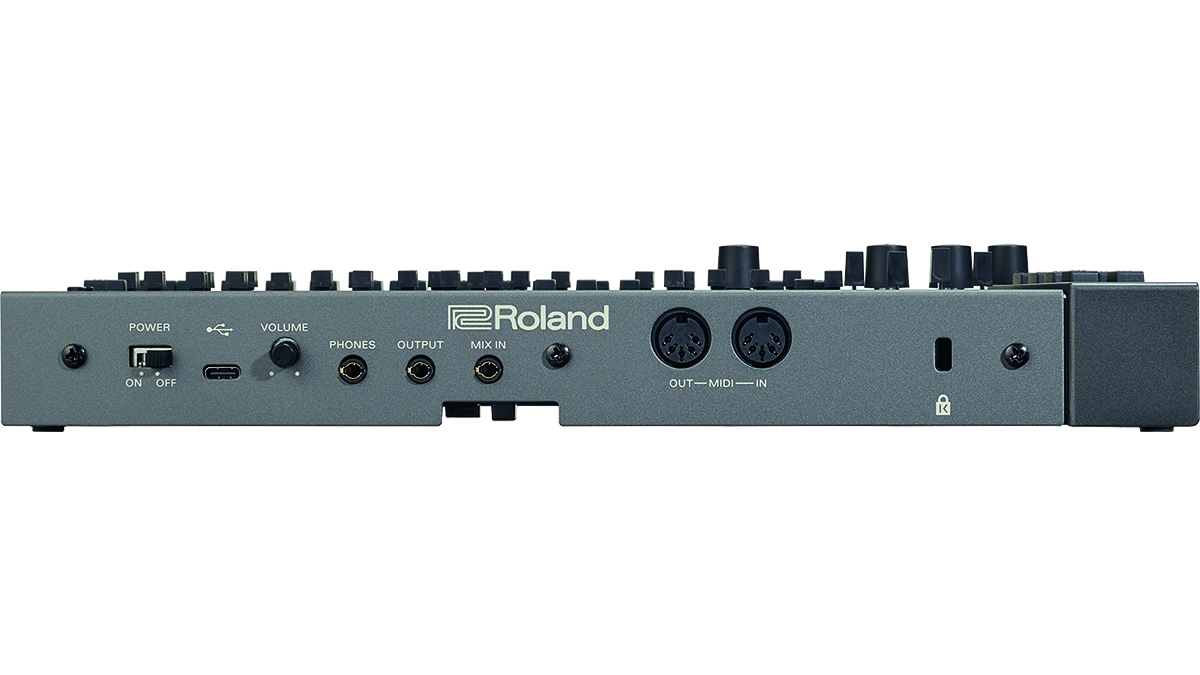
Initially, this gets a little confusing, not helped by the original JD trying to control the new JD with some random program changes. But eventually, we have it set up so that we are comparing the sounds next to one another on separate Logic DAW channels. First of all, they’re not quite identical.
The actual presets are the same sounds, of course, finely modelled to deliver all the shimmer, sparkle and movement of the original. But the original keyboard certainly exhibits more body on occasion, albeit sometimes because it’s routing its sounds through more effects. All set up and dry, there’s a subtle difference and a hint more oomph on the original.
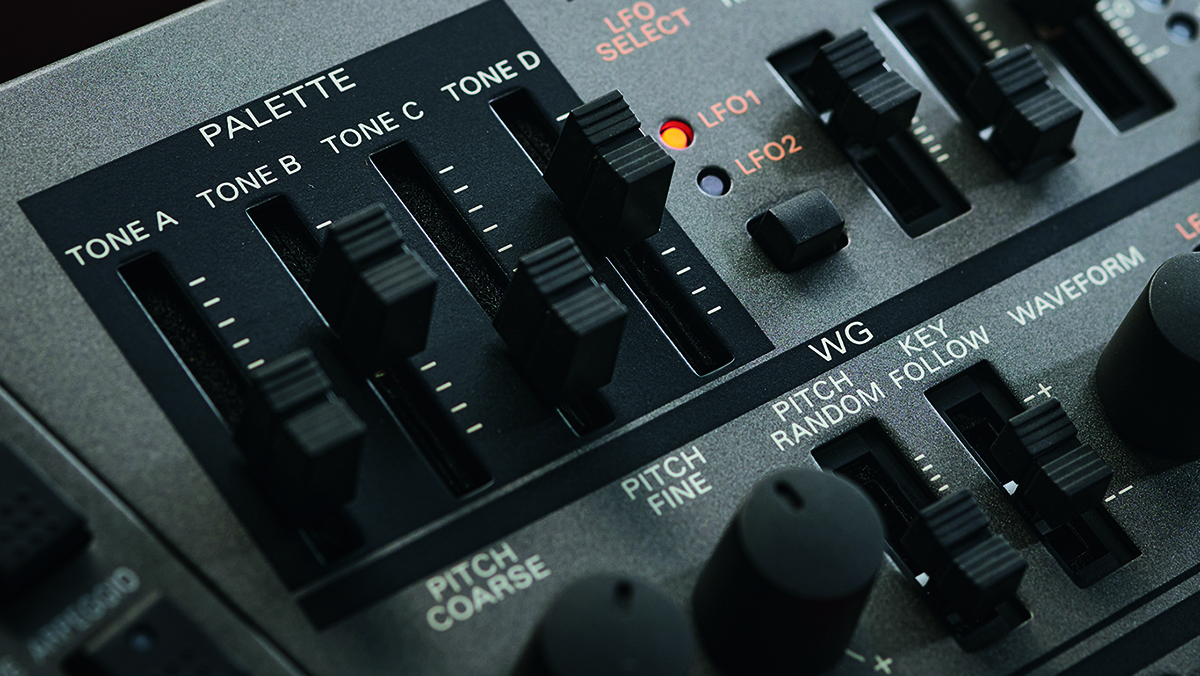
Overall the JD-08 does sound excellent though; as near as dammit to the original and those sounds will transport you straight back in time. You get fine D-50 style west coast keys, huge distorted guitar sounds – most of which should probably have stayed in the ’90s – and some incredible evolving strings and pads.
And these types of sounds are what the original and new JD-08 excel at. The pads were always the most inspiring side of the original and they really do translate well here.
The real power play here is that you can quickly layer up strings and pads just by switching in up to four of those tones. It’s easy, then, to create huge supersaw sounds with a little subtle detuning between layers to get massive analogue-style strings. But then, should you wish, it’s just as easy to bring in a random wave on one of the layers to completely change the entire mood and get a more digital result. It’s really what the original was about, mixing the best of both analogue and digital, and it all comes across on the 08.

Architecture
The original 1991 hardware synth – and its modern hardware and software counterparts including the JD-08 – all use a synthesis architecture that is actually an updated version of the Linear Arithmetic (LA) synthesis used in another Roland synth classic, the D-50.
You essentially get four layers or tones within a patch to work with, each based on a sampled waveform and 108 of these to choose from. They are longer than the more attack-natured samples used in the D-50 and when the four tones are merged – essentially four synth engines combining – the JD-800 is capable of much bigger and more diverse sounds.
The rest of the synthesis architecture is recognisably subtractive, although Roland sometimes give various sections different names to throw you off the scent. But you do get a digital filter (called a TVF) plus filter, amplitude and oscillator envelopes and a couple of LFOs.
The synth was also known for its big, two-stage effects section, one more distortion-based and the other with reverb and delay and those are here in the JD-08 too.
Spectrasonics guru Eric Persing described it as the Stealth Bomber of synths.
Conclusion
Like other Boutiques, of course, the JD-08 is a nostalgic synth. Yet while the virtual analogues in the range have a sound that is much more widely used in contemporary genres, the sound of the JD-08 won’t be to everyone’s liking; we can’t see it being as applicable to 2022 as, say, the JP-08 is, for example. However, when you line up its bi-timbrality and launch two four-layered sounds at the same time, there really is nothing quite like it.
If there’s any kind of resurgence in ’90s music happening anytime soon then this is the beast to get. Add in its portable ambitions, interfacing options and price – at least compared to the original – this is a great little synth that amply recreates one of the biggest.
MusicRadar verdict: Adds lovely modern flourishes in an unashamedly nostalgic look and does it all within a ridiculously compact design.
Roland JD-08: The web says
"This is a synth which deserves to be taken seriously for its impressive and distinctive sound as well as its hands-on approach to sculpting and tweaking patches."
JunoDaily
Roland JD-08: Hands-on demos
RolandChannel
sonicstate
Andertons Synths, Keys and Tech
Roland JD-08: Specifications
- KEY FEATURES: Four-part sound engine based on JD-800; 256 factory preset locations (including 64 original sounds), 128 patterns and 108 original waveforms; 2-part multitimbral; up to 128 voices of polyphony; 2 part, 64 step sequencer, 8 notes polyphonic per part; two-stage multi-effects with 7 main types; arpeggiator.
- CONNECTIONS: headphones, output, mix in (all on stereo mini jack); external clock in (mono mini jack), MIDI in and out, USB-C (audio and MIDI).
- CONTACT: Roland
Andy has been writing about music production and technology for 30 years having started out on Music Technology magazine back in 1992. He has edited the magazines Future Music, Keyboard Review, MusicTech and Computer Music, which he helped launch back in 1998. He owns way too many synthesizers.
